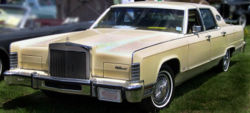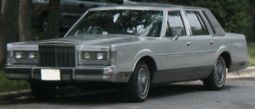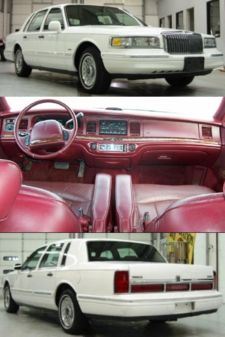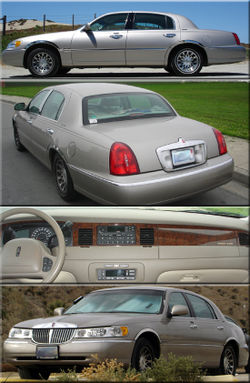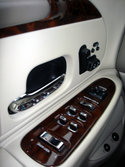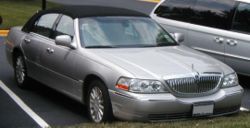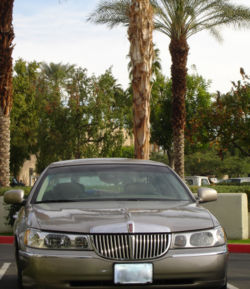Lincoln Town Car
2007 Schools Wikipedia Selection. Related subjects: Road transport
| Lincoln Town Car | |
 |
|
| Manufacturer: | Ford Motor Company |
|---|---|
| Production: | 1981–present |
| Assembly: | Wixom, Michigan St. Thomas, Ontario, Canada after 2007 |
| Predecessor: | Lincoln Continental |
| Class: | Full-size luxury car |
| Body style: | 4-door sedan |
| Layout: | FR layout |
| Platform: | Ford Panther platform |
| Related: | Mercury Grand Marquis Mercury Marauder Ford Crown Victoria |
| Similar: | Jaguar XJ Lexus LS Mercedes-Benz S-Class |
The Lincoln Town Car is a full-size luxury sedan and serves as the flagship of Ford's Lincoln luxury car division. Often referred as a traditional American luxury sedan the Town Car features a V8 engine, rear wheel drive, very generous exterior and interior dimensions as well as a "Pillowy ride and chrome aplenty." (Forbes) The Town Car is currently the largest American-made car, measuring nearly 18 feet (5.49 m) in length for a standard Town Car and 18 1/2 ft (5.64 m) for an L Edition. The Town Car's main competitors include the Lexus LS 460 and Cadillac DTS. Manufactured in the Wixom Assembly Plant, the Town Car is, despite recently declining sales numbers, one of the best selling American luxury cars. It also serves as America's most used limousine, especially as its main competitor, Cadillac is said not to be as dependable. While relatively affordable when compared to European flagship luxury sedans, the Town Car is currently the most expensive American luxury sedan (according to base MSRP) with prices ranging from US$42,875 for a basic Signature Series to $56,745 for a top-of-the-line Signature L Series.
|
Lincoln is the only domestic automaker offering big rear-drive luxury cars... the company has done well with its new Town Car. Whether you've got a 500-mile day ahead of you or it's your turn to take the foursome to the course for 18 holes. -Edmunds.com |
Ford at one time had considered ending production on Lincoln's flagship model after the planned closing of the Wixom Assembly Plant in Wixom, Michigan in 2007. Ford ultimately decided to keep the model and move assembly to the St. Thomas Assembly Plant in Ontario, Canada where the Ford Crown Victoria and Mercury Grand Marquis, which also use the Ford Panther platform are currently built. The Town Car's manufacture will resume at its new location in late 2007.
Name
It is probably not a coincidence that "Town Car" is a translation of Cadillac's " Sedan de Ville," a model which was gaining popularity in the 1950s. Both names refer to a classic style of limousine, popular in the 1920s, which had an open chauffeur's compartment up front, but only Lincoln has sometimes attempted to make its modern models visually suggest their older namesakes. As an example, note the vinyl roof covering on the 1979 model shown below. It sweeps down the centre pillar as part of a raised molding, complete with opera lamps, which suggests a partition between front and rear seats, while no vinyl is applied to the front section of the roof over the driver.
History
The Town Car name appeared on several trim levels on the Lincoln Continental flagship sedan in from 1959 to 1980. In 1981, the Lincoln Town Car became a model in its own right and became Lincoln's largest sedan as well as its flagship vehicle. Since then, there have been three generations of the Town Car with additional minor redesigns, one in 1995 and another one in 2003.
Pre-1981
The Town Car name first appeared in the Lincoln line in 1959, on a special limousine-like version of the standard Continental. This first Town Car was available only in black and was identifiable by a unique padded vinyl top, which was a rarity at that time.
After its first appearance in 1959, the Town Car name went dormant for 10 years, and re-emerged as an especially plush interior option package for the 1969 Lincoln Continental.
It next appeared as a trim option in 1971, and thereafter continued through 1980 as the top-line trim option package for the Lincoln Continental. Again, the Town Car trim featured an extra plush interior along with, usually but not always, a landau vinyl roof over the rear passenger compartment. The Town Car badge has always been applied to sedans, but from 1975 to 1980, there was a similar option for coupes called the Town Coupe.
First generation
| First generation | |
 |
|
| Production: | 1981–1989 |
|---|---|
| Engine: | 5.0 L V8 |
| Transmission: | 4-speed automatic |
| Wheelbase: | 117.3 in (2979 mm) |
| Length: | 219.9 in (5585 mm) |
| Width: | 78.1 in (1984 mm) |
| Height: | 55.9 in (1420 mm) |
| Curb weight: | 4044 lb (1834 kg) |
| Fuel economy: | 17 mpg (US) (13.8 L/100 km)/city 25 mpg (9.4 L/100 km)/highway |
| Fuel capacity: | 18 US gal (68.1 L) |
Since 1981, the Town Car has been considered a model in its own right, replacing the Continental (whose name reappeared a year later on a smaller model). Upon its introduction, the Town Car immediately became Lincoln's flagship model, a purpose it continues to serve to this day.
The first generation Town Car featured a body profile and grille similar to that of the late 1970s Lincoln Continental. The interior layout included new seats, dashboard and door panels. The exterior door panels and fenders were also completely new, while the taillights and trunk lid experienced a slight redesign. To keep up with current design trends, the previously covered headlights were now exposed and composed of two adjoining square units.
The first generation Town Car also featured many advanced luxury options for its time. While leather trim was only available on the Cartier edition, all trim levels featured six-way power seats as well as an optional 12-speaker JBL audio system.
Similar to the Continental Town Car package, a half-vinyl coach roof with frenched rear window was also a standard option on the Signature and Cartier models.
It is important to note that although 1981 was the first year of the Town Car as a separate model, it was in 1980 that the Panther platform Town Car was introduced under the previous model name "Continental Town Car". The introduction of the Panther platform Town Car in 1980 was also the end for 400 in³ and 460 in³ V8 engines in Lincoln's line-up; they were replaced with the very popular 302 in³ (5.0 L) V8. The transmission also changed to a 4-speed automatic with overdrive.
1985
For 1985, the Town Car received minor design updates. Like previous years, the design scheme introduced for 1985 included a reflector running in between both taillights underneath the license plate frame, a design feature kept for the second generation Town Car. 1985 also saw the introduction of newer more ergonomically designed seats, featuring enhanced lumbar support.
Second generation
1990
In 1990, the Town Car's body went through a major redesign and a rear air suspension was added as standard equipment. That year, it was also named as Motor Trend's Car of the Year. Through most of this model run, the car was available in four trim levels: Town Car (Pre-cursor to the Executive Series ending in 1990), Executive (beginning with the 1991 model year), Signature, and Cartier, in increasing order of price and appointment of features.
The 1990 Lincoln Town Car also marked the end of the Town Car's 1970s-based angular design. The wedges on the side of the hood which contained the parking and signal lights were removed and the Rolls-Royce-like grille was replaced with a more modern and more aerodynamic front fascia. Parking lights were now located adjoining to the grille and the headlights wrapped around the corners of the front. The door panels and fenders were replaced as well, while the trunk lid and taillights remained somewhat more similar to the 1980s model. The revised interior featured a new dashboard, seats, and interior door panels.
Introduced in 1990 were several new options that had never been available before on a Town Car. Memory seating with power front passenger and driver lumbar and recliner support was an option on Signature Town Car and standard on Cartier Town Car. The Electrochromatic Dimming Mirror was also a carryover option from the 1989 Town Car. Also being introduced as standard equipment for all Town Cars during the 1990 model year was a new digital instrumentation system with a more advanced message centre that gave the following: Distance to Empty, Fuel (Gallons) Remaining, Outside Temperature, Average Fuel Economy, Instant Fuel Economy, and two trip odometers. The digital instrumentation would not be standard on 1991 or 1992 Executive Series models, but would become standard again for the 1993 Executive model and remain standard on all models through 1997.
1991 saw the introduction of Ford's new Modular V8, an SOHC design replacing the Ford 302 Windsor. Also standard in 1991 were dual front driver and passenger airbags.
Overall the second generation Town Car was an overwhelming sales success and quickly became one of America's best selling full-size luxury sedans. During the late 1980s and early 1990s, Town Car sales regularly exceeded 100,000 units with 120,121 Town Cars being sold in 1994 alone.
1995
The Town Car underwent a minor exterior facelift for the 1995 model year. Changes to the exterior included smaller, clear headlights as well as additional running lights in the rear.
The interior was completely revamped. The Town Car received a new dashboard, new seats and new interior door panels. The angular interior shapes from the 1990 to 1994 model's interior were replaced by more modern-looking curved design elements. Many of the new interior components, such as the dashboard, featured a so-called "organic" design. 1995 also saw the introduction of a new steering wheel, which was used in all Panther-based sedans until 2004.
Also introduced in 1995 was a new digital dash layout that featured a more italisized look to the readouts and a new feature called "Average Speed." This feature, on all digital instrument panels until the 2005 overhaul, calculated the average travel speed over a period of time. Every other function remained the same from the 1990 overhaul of the digital dash. Memory seats with power lumbar support also became standard on Signarture Series sedans during this time as well.
Special Editions
1992 and 1993 saw a special Signature Series sedan come to market: the Jack Nicklaus Signature Series, which featured a green body with a white vinyl top with white leather interior trimmed in green. Most of these editions have ornaments and wording on the exterior trimmed in gold . Options included on the 1992 and 1993 Jack Nicklaus Signature Series included: Memory Seats with Power Lumbar/Recliner, Leather Seats, and Monotone Paint.
1995 also featured another special Signature Series edition called the Spinnaker Edition which featured tri-coat paint, the Spinnaker logo on the floor mats, and 16-inch spoked aluminium wheels.
To celebrate Lincoln's 75th anniversary in 1996, the Town Car took on a "Diamond Anniversary" edition. This edition was applied to Signature Series sedans only. Options included a paint strip down the side, leather seats, wood instrument panel trim, window badging, cellular telephone, power moonroof, JBL audio system, auto electrochromatic dimming mirror w/compass, and traction assist.
Also introduced in 1996 were the Ride Control and Touring Edition packages. Ride Control was only available on Signature and Cartier Town Cars while Touring Edition was available for all Town Car models. Ride control featured an auziliary power steering fluid cooler, 16-inch aluminium wheels, 225/60/16 tires, 3.27 axle ratio, 28.5 mm stabilizer bar, and revised air springs and shocks. Touring Edition featured a power moonroof, JBL audio system, auto dimming headlights, auto electrochromatic dimming mirror, auxiliary power steering fluid cooler, 16-inch aluminium wheels, 225/60/16 tires, 3.27 axle ratio, 28.5 mm stabilizer bar, and revised air springs and shocks. Both the Ride Control and Touring Edition packages would last only between 1996 and 1997; however, the Touring Edition package would make a brief comeback during the 2000 model year
Third generation
The 1990 body style remained primarily unchanged until the next new body style premiered in 1998, a redesign which included the removal of the car's hood ornament and more angular shapes. The Cartier model also received a 220 hp version of the Modular V8.
The more boxy Town Car design of the 1990s was replaced by a curvacious design scheme with a downwards sloping trunklid, pursed lip grille and cat-eye headlights.
While the Town Car lost three inches in overall length, the new Town Car was two inches wider, one inch taller, and weighed 600 pounds more. The post-1997 Town Car features a slightly longer wheelbase as well.
The interior was also completely redesigned. Door and instrument panels as well as the radio face, switches and controls were redone. Additional wood trim was added to the newly designed dahsboard and the door panels. The power seat controls were moved to the door panels. Lincoln emblems were also added to the door panels.
A factory option available to individual owners of Town Cars since 2001 has been a version of the Town Car with an extra six inches of rear seat legroom, designated as the "L" or "long" version. This model provides extra amenities for rear-seat passengers, including a unique rear-seat switch that allows the front-passenger seat to be moved forward as desired for extra room in the rear.
A Touring Edition also became available in late 2000. The Touring Edition featured a more powerful 235 hp version of the Town Car's Modular V8 engine, dual exhaust pipes and unique 16 inch alloy wheels with larger tires.
2003
A minor body redesign in 2003 added the hood ornament back again. 2003 also marked the last year that the Town Car was available in a trim package with the name "Cartier" (1981 to 2003). Beginning with the 2004 model year, the top-of-the-line Town Car was instead designated as the "Ultimate". The Touring edition (on the Signature model only) was dropped likely because the handling of 2003 Town Cars were far better than last year's Touring edition. The 4.6 L V8 with 239 hp was also introduced for the 2003 model year.
The interior remained largely unchanged for 2003. More brushed satin metals and an analog clock were added to the interior. The Lincoln emblems on the door panels were removed and the radio face including climate controls received a facelift.
For the 2005 model year, the Ultimate trim level was dropped. The trim levels for the 2005 Lincoln Town Car were: Signature, Signature Limited, and the Signature L with a lengthened wheel-base.
For 2006, the model trim levels were changed again. The trim levels for the 2006 Town Car are: Signature, Signature Limited, Designer, and Signature L.
The Town Car overwhelmingly dominates the limousine market in the United States, since it is the only American luxury car still in production with body on frame construction, making the production of stretched versions easier than with unibody construction.
Trim levels
In 1981 the Town Car was introduced in three trim levels, the base Executive Series, the mid-range Signature Series, and the top-of-the-line Cartier. The trim levels remained unchaged until 2003, when the Executive Series and Cartier names were dropped. The Signature Series did not any longer represent the mid-range model, rather it replaced the Executive Series with Ultimate designation being used for the mid-range and top model, which was formerly called the Cartier. In 2005, however, the lineup was changed again. For 2005 only, the Ultimate designation was dropped, with only the Signature Series designation being used for all three trim levels. In 2006, Lincoln introduced the Designer Series as an additional trim-level to fit in between the mid-range Signature Limited Series and the top Singature L Series.
Executive (1981 - 2003)
The Executive Series was the basic trim levels and thus also most affordable trim level on the Lincoln Town Car from 1981 through 2003. The Executive Series designation is still used today, but only on fleet vehicles.
Signature (1981 - present)
The Signature Series was the mid-level trim and was also the most popular trim level from 1981 through 2003. In 2004 the trim levels were renamed, and the Signature Series was now used to describe the basic trim level and Ultimate was now used to describe the mid-level trim. In 2005 the Ultimate was dropped and all trim levels were changed to a version of Signature. The basic trim level for 2005 was called Signature, the mid trim level was called Signature Limited and the top-of-line trim-level was called Signature L. The trim level designations were revised again for the 2006 model year. For 2006 a trim level called the Designer Series was added between the Signature Limited and top-of-line Signature L.
Cartier (1981 - 2003)
Cartier was used on the top-of-line Town Car from 1981 through 2003. The Cartier also featured its own version of Lincoln emblem which was stitched onto the seats. Golden Lincoln emblems on the tail-lights also became a staplemark on the Cartier Edition on 1998 through 2002 models.
Ultimate (2004 only)
Ultimate was only used on the 2004 Town Car. Ultimate designation was the mid-level trim, while Ultimate L was the designation used for the top-of-line Lincoln.
L Edition (2001 - present)
The designation "L" was used on Lincoln Town Cars with extended wheelbases. The L editions offer an additional six inches of legroom as well as separate audio and climate controls for rear passengers. While this desgination is similar to that used on other luxury flagship sedans such as the BMW 7-Series or the Mercedes-Benz S-Class, the "L" designation was never its own trim option on the Town Car. Instead the L edition was applied to the top-of-line Cartier (2003), Ultimate (2004 only), and Signature (2005 - present) Series trim levels.
Designer (2006 - present)
The Designer Series is an upper-middle trim level in between the mid-level Signature Limited and top-of-the-line Signature L. The Designer Series is roughly $1,000 more expensive than the mid-level Signature Limited with a starting MSRP of $45,915.
Trim level timeline
| Lincoln Town Car Timeline | ||||||||||||||||||||||||||||||||||||||||||||||||||||||||||||||||||||||||||||||||
| Trim level | 1980s | 1990s | 2000s | |||||||||||||||||||||||||||||||||||||||||||||||||||||||||||||||||||||||||||||
| '80 | '81 | '82 | '83 | '84 | '85 | '86 | '87 | '88 | '89 | '90 | '91 | '92 | '93 | '94 | '95 | '96 | '97 | '98 | '99 | '00 | '01 | '02 | '03 | '04 | '05 | '06 | ||||||||||||||||||||||||||||||||||||||||||||||||||||||
| Entry | Executive Series | Signature Series | ||||||||||||||||||||||||||||||||||||||||||||||||||||||||||||||||||||||||||||||
| Mid-level | Signature Series | Ultimate | Signature Limited | |||||||||||||||||||||||||||||||||||||||||||||||||||||||||||||||||||||||||||||
| High-end | Designer Series | |||||||||||||||||||||||||||||||||||||||||||||||||||||||||||||||||||||||||||||||
| Top-of-the-line | Cartier | Ultimate L | Signature L | |||||||||||||||||||||||||||||||||||||||||||||||||||||||||||||||||||||||||||||
| L Edition | L Series | |||||||||||||||||||||||||||||||||||||||||||||||||||||||||||||||||||||||||||||||
Awards
Over its twenty-five year run, the Town Car has become one of best selling luxury cars of the United States and received several awards in the process.
- Highest Customer Satisfaction. According to J.D. Power and Associates the Lincoln marque has the highest customer satisfaction of any car brand. "Lincoln outperforms other brands in the areas of service initiation and user-friendly service. Lincoln customers are particularly pleased with the dealership’s ability to get them in for an appointment within a reasonable amount of time and the fairness of charges. Lincoln is the first domestic make to rank highest in CSI for two consecutive years." - JD Power Associates 2005. Lincoln is followed by Cadillac, which ranked second, and Lexus which ranked fourth in the study.
- Highest Customer Loyalty. Over two-thirds of Town Car buyers are repeat buyers with 60% not even considering the purchase of another luxury vehicle besides the Town Car.
- Roominess. According to Forbes, Edmunds.com and NCTD, the Town Car is the most spacious luxury sedan under $200k; an honour easily proven by the interior's generous dimensions. A standard wheel-base Town Car features 112.7 ft³ of interior volume versus 105 ft³ in the Mercedes-Benz S 600 or 111 ft³ in the extended wheelbase BMW 760il. The difference is even greater when comparing the Signature L Series with its enormous 120.5 ft³ of interior space.
- One of the best chauffeured cars. Forbes magazine repeatedly named the Town Car one of the best cars to be chauffeured in, ahead of other, often more expensive flagship sedans, such as the Mercedes-Benz S-Class, BMW 7-Series and Lexus LS. The Town Car Signature L features a rear seat comfort package which not only provides rear seat passengers with audio system and rear compartment climate controls, but also features a control function which allows for the rear seat occupants to move the passenger seat forward, a feature exclusive to few ultra-luxury sedans. In addition to its many amenities, the Signature L also features an unrivaled 46.9 in of rear legroom, and 60 in of rear shoulder room.
- Highest Possible Safety Rating. The Town Car has repeatedly earned the government's highest five star safety rating, a rating that shouldn't come as surprise considering the vehicle's overall length, width, and large overhangs. "Five stars in five categories. Town Car is the first car in automotive history to receive a five-star rating in all five categories" - Lincoln web-site. The Town Car is also the only vehicles to receive a five star rating in all five categories for five years in a row, from 2001 to 2006.
- Quietness. The third generation Town Car is one of the quietest vehicles on the road with an interior noise level of only 36 decibels while idling. The average decibel rating for a vehicle is roughly 45 decibels with the world's quietest car, the Lexus LS averaging 32 decibels.
- Car of the Year. In 1990, upon the introduction of the second generation Town Car, the vehicle received the honour of being named Motor Trend Car of the Year.
Engine Specifications
| Trim level | Year | Engine | Power | Torque |
|---|---|---|---|---|
| First Generation | ||||
| Executive Signature Cartier |
Late 1981–1989 | 5.0 L Windsor V8 | 150 hp (112 kW) | 270 lb.-ft. at 2,000rpm |
| Late 1981–1989 | (Dual Exhaust) | 160 hp (112 kW) | 280 lb.-ft. at 2,200rpm | |
| Second Generation | ||||
| Executive Series | 1990 | 5.0 L Windsor V8 | 150 hp (112 kW) | 270 lb.-ft. at 2,000rpm |
| 1991–1996 | 4.6 L Modular V8 | 210 hp (157 kW) | 275 lb.-ft. at 3,250rpm | |
| 1997 | 190 hp (142 kW) | 265 lb.-ft. at 3,250rpm | ||
| Signature Series Cartier |
1990 | 5.0 L Windsor V8 | 160 hp (112 kW) | 280 lb.-ft. at 2,200rpm |
| 1991–1997 | 4.6 L Modular V8 | 210 hp (157 kW) | 275 lb.-ft. at 3,250rpm | |
| Third Generation | ||||
| Executive Series Signature Series |
1998–2000 | 4.6 L Modular V8 | 205 hp (153 kW) | |
| 2001–2002 | 220 hp (164 kW) | 275 lb.-ft. at 3,500rpm | ||
| 2003– | 239 hp (178 kW) | 287 lb.-ft. at 4,100rpm | ||
| Signature Touring Signature Limited Ultimate Designer Series |
2000–2002 | 239 hp (178 kW) | 287 lb.-ft. at 4,100rpm | |
| 2004-present | ||||
| 2004 | ||||
| 2006-present | ||||
| Cartier | 1998–2000 | 220 hp (164 kW) | 290 lb.-ft. at 3,500rpm | |
| L Edition | 2001–2002 | 235 hp (175 kW) | 285 lb.-ft. | |
| 2003– | 239 hp (178 kW) | 287 lb.-ft. at 4,100rpm | ||

